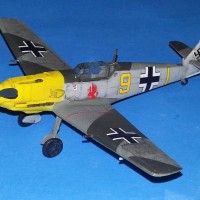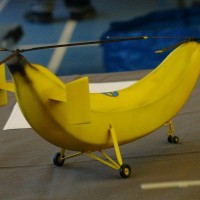The Deterrent
Thanks are once again due to Özkan Türker whose wonderful help enabled me to complete this model.
Historical Background
There was a common threat facing the countries bordering the Aegean - that of fascist Italy. Mussolini had made his aims of restoring a Roman Empire very clear and the Italians were engaged in fortifying islands and generally making an unwanted nuisance of themselves. Ataturk, president of Turkey could see the way things were going and also a threat to Turkey itself if Italy was allowed to pursue its goals. His response was diplomatic (the Balkan pact with Greece, Yugoslavia and Romania in 1934 which guaranteed each country's borders in the case of an attack by Italy or Albania) but something a bit more solid was also needed. When Italian activity in the Aegean islands continued Ataturk contacted the Head of the Air Force with a simple instruction,
'Research and purchase a bomber plane that can bomb Rome and return without being detected by enemy fighters' (''düşman avcı uçaklarına yakalanmadan roma'yı bombalayacak ve geri dönebilecek bir bombardıman uçağının varlığını araştırın ve satın alın.'').
Turkish attention was drawn to the (then) very advanced Martin B-10 which had become available for export as the Martin 139 W. The test pilot Enver Akoğlu was sent to America to try out the aircraft. Martin had filled the aircraft with water tanks to simulate a loaded plane for the test flight but due to incorrect connection of the water discharge mechanism the plane started to fill with water. The Martin test pilot panicked and Akoğlu faced the very real possibility of being drowned in flight - an aviation first as he later remarked. However, he was able to regain control of the aircraft and avert the danger. Despite this incident the final evaluation was favourable and 20 or 24 Martin 139 WTs were ordered (sources differ) with the first being delivered in September 1937. The aircraft differed chiefly in their engines which were 1,000 hp versions of the R-1820 engines. The Italians were furious especially as the planes were deployed at Çorlu which was in easy striking distance of Rome but the message was effective. They were assigned to an Independent Martin Battalion before transferring to the 1st Air Regiment in 1941 but never needed to drop their bombs in anger serving the purpose they were purchased for with honour and ease. Mostly used for the reconnaissance and observation role over the Black Sea the Turkish 139 WTs lingered on until 1946 before being retired.
Colour Scheme
Most models one sees of Turkish Martin 139s have their upper surfaces painted a true orange and indeed the original paint scheme specifies Dupont 83-2588 Orange as the colour used. Dupont no longer do paint and company records don't seem to have survived. Turkish sources who have seen samples of this paint indicate that this paint was towards the yellow range of the spectrum and Özkan in his research equates this to FS13538 (chrome yellow). This makes sense as Chrome Yellow is a very orange yellow and matches the colour contrasts of surviving photos (which seem to be panchromatic) very well. AK paints do a chrome yellow - as AK 11042 'Volcano Yellow' and this is the paint I used.
The Model
For a long time the only model of a B-10 available was the Williams Brothers kit which was getting a bit long in the tooth and needed modification if one wanted to make an accurate Martin 139 WT. This has been replaced by a more up to date offering from Special Hobby/Azur which comes in various versions. If one wants a Turkish aircraft one needs the Special Hobby offering. The kit is nicely molded but watch out for the wings. Assembly of these is problematic and I had issues both with this kit and a different version (which I built as a YB-10 of the Alaska Flight). Otherwise the kit goes together quite well. It comes with a comprehensive interior, most of which will be invisible but it's nice to know it's there. There's also a small and useful etched brass sheet.
The kit goes together well (apart from the afore-mentioned wings). Of course with Special Hobby one cleans the mating surfaces and adds filler; this kit is very filler friendly. Attaching the wings to the fuselage looks well designed but in practice needs a bit of a knack. Either one doesn't glue the wing spar (incidentally watch out for short shorts with the spar location groves) and then attaches the wings via the molded on flanges or one glues the spar and then removes the flanges. I chose the latter and would recommend it as getting the flanges to fit isn't easy. The engine nacelles need considerable sanding and filling to get looking anything like the prototype but the kit engine is a nice piece of work. In a small Special Hobby brainfart, the exhaust pipes aren't symmetrical but exactly the same and are a bit of a struggle to fit. The same can be said of the transparencies which also require careful masking and painting. Additions were limited - one footstep was all. I also dropped the elevators slightly to represent the prototype configuration.
The instructions are surprisingly clear and differences between aircraft clearly marked. I replaced the pitot tubes with scratch built items and left off the radio mast (not present on early aircraft) but parts are included should one wish to have it fitted. Decals went on well and were robust. I did modify the kit decals making my particular aircraft #1. Special Hobby include some decals for small tail numbers but none of the photos I've seen show the actual aircraft carrying these so these were omitted. Painting was the above mentioned AK 11042 which proved to be a difficult paint to use and not particularly keen on providing a nice finish. However, the end result fully justifies the choice. The undersides were painted Tamiya XF-16 Matt Aluminium which is a nice paint to use.
Varnishes used were Tamiya semi-gloss clear for the upper surfaces and matt clear for the under surfaces.
Conclusion
All in all a pleasurable build. The Azur/Special Hobby Martin B-10/139 series does require a lot of work and effort but for the most part it's pleasurable effort. The wings are the hardest part but the issues can be solved. The decal sheet is nice and the end result is a real eye catcher of an aircraft.









Excellent result, thoroughly researched as always, Christopher! What a great subject chosen! Never knew Turkey had those bombers. Very informative writeup.
Well done!
Many, many thanks for the kind comments, Spiros - the B-10 was quite a popular export aircraft and the background story to these is quite interesting.
That's a fine looking build, Christopher @christopher
All the background information is new to me as well, thanks a lot for sharing
Hi John - much appreciated and thanks for the comments.
Nicely done and presented Christopher.
Thanks ever so much Allan.
Really nice work Christopher (@christopher). You got a really nice result on an airplane that is rarely seen on these pages. The paint scheme is striking and came out particularly well.
That's really kind of you to say so George (@gblair), Many thanks. It is a very striking scheme and from the accuracy angle also correct.
Very nice build. I always found the B-10 a fascinating design. Thanks for posting it.
Thanks ever so much Russell. I agree totally about the B-10
Looks great! I think that scheme fits the aircraft more pleasingly than the USAF pre-war scheme.
Thanks very much Greg! The scheme is very striking. I always thought they looked good in the USAF green/yellow scheme as well (only the YB-10s carried this though)
Nice build of a lesser known variant of the B-10. Very interesting.
Many, many thanks Chas - it is an interesting variant.
Thanks much for the history lesson about things I was unaware of, @christopher.
The model looks great. I admit I have this kit and it has gotten set aside due to those "issues." Good on you for persevering.
Many thanks for the generous comments Tom! (@tcinla). They actually build up well and it's really only the wings that have issues. These are solvable.